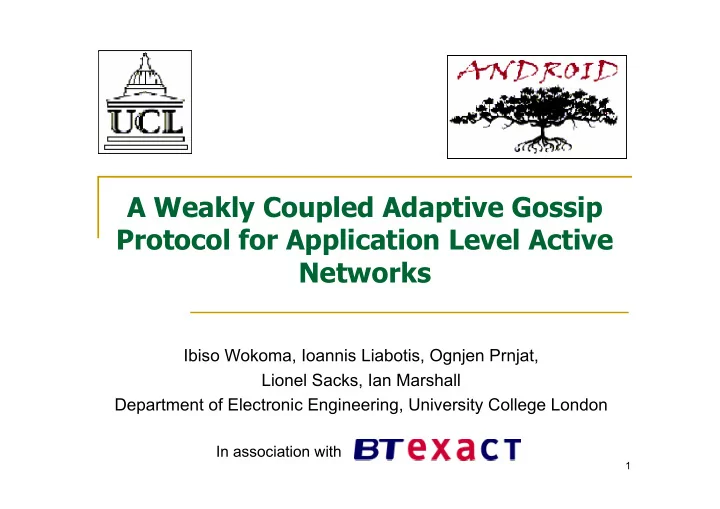

A Weakly Coupled Adaptive Gossip Protocol for Application Level Active Networks Ibiso Wokoma, Ioannis Liabotis, Ognjen Prnjat, Lionel Sacks, Ian Marshall Department of Electronic Engineering, University College London In association with 1
Problem Space � Policy management of distributed networks requires that system and node policies are updated regularly � The distribution of the updates needs to be � asynchronous � scalable, reliable and independent of the underlying topology � implemented without centralized planning � The proposed protocol satisfies these requirements 2
Gossip protocols � Efficient method of distributed information dissemination in wide-area networks � Delayed propagation that provides weak consistency and better availability � e.g. Time Stamped Anti-Entropy (TSAE) Before anti-entropy A 3 5 6 10 A 3 5 Node B B 2 8 14 B 2 8 14 C 7 4 C 5 7 Log A Sum A Log B Sum B A 3 5 6 10 After anti-entropy Node A B 2 8 14 C 7 5 7 Log A, B Sum A, B 3
Firefly synchronization 4
Firefly synchronization � A biologically inspired model based on fireflies was designed � Fireflies alter their internal timers to flash at the same rate as their neighbours � An example of self organization using a non- deterministic distributed mechanism timer = 1 timer = 15 timer = 2 timer = 16 timer = 4 timer = 0 timer = 10 timer = 7 timer = 11 timer = 8 timer = 14 timer = 10 t = 1 epoch t = 2 epochs t = 3 epochs 5
Firefly/Gossip Model (1) � The functional requirements for this model are: � low network traffic and synchronization time � scalable � efficiency in different networks � To achieve this, each node is given a: � timer � flash interval – period the node waits before it “flashes” i.e. communicates with its neighbours � event record – a list of the node’s neighbours with an indication of how frequently they have flashed � hash table – a list of the policies added to the node with a timestamp for each 6
Firefly/Gossip Model (2) yes For each epoch and for Randomize timers Is timer larger each node in the network, than 0? decrement timers no Subsequent flashes result in changes The node broadcasts its’ hash table to to the event records; if the neighbours its neighbours who add the flashing have not flashed much in comparison node to their event record if its not to the node being analysed then it is already there and compare hash tables removed from the list Has a new policy been found? yes no Reset timer to the value of the Increase the Decrease the flash interval flash interval flash interval 7
Optimization tests 8
Scalability tests 9
Topology tests 10
Conclusions � An autonomous and self-organized method of distributing updates in systems such as active networks, GRID and sensor networks � The mechanism is robust in response to node failures and performs better than TSAE � Further work could involve assessing how the algorithm works in small worlds and scale- free topologies and with different policy arrival rates 11
Recommend
More recommend